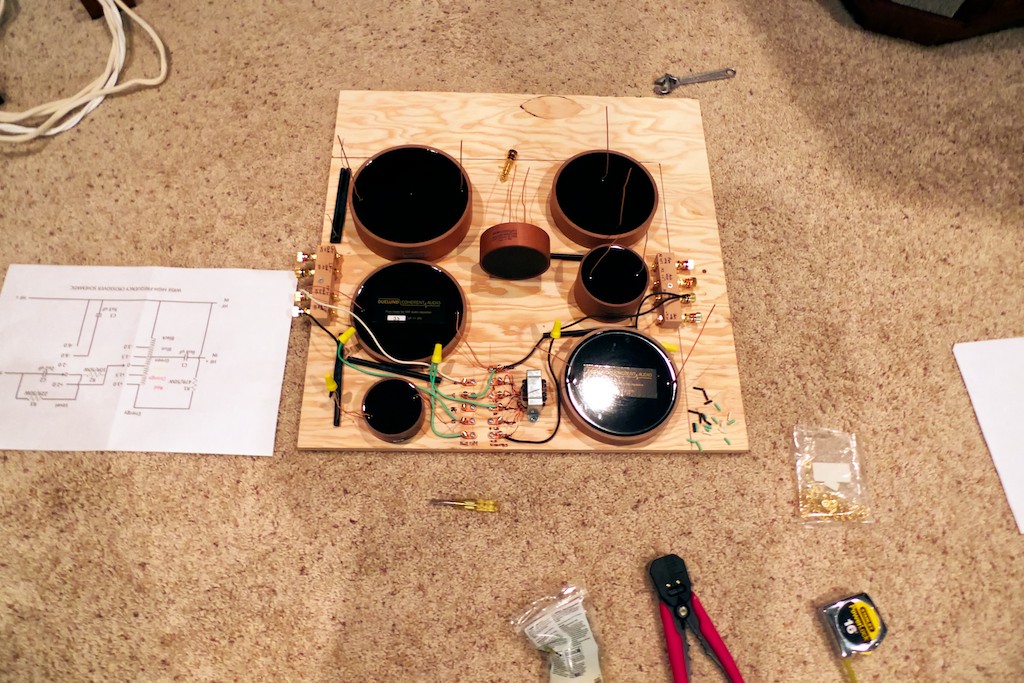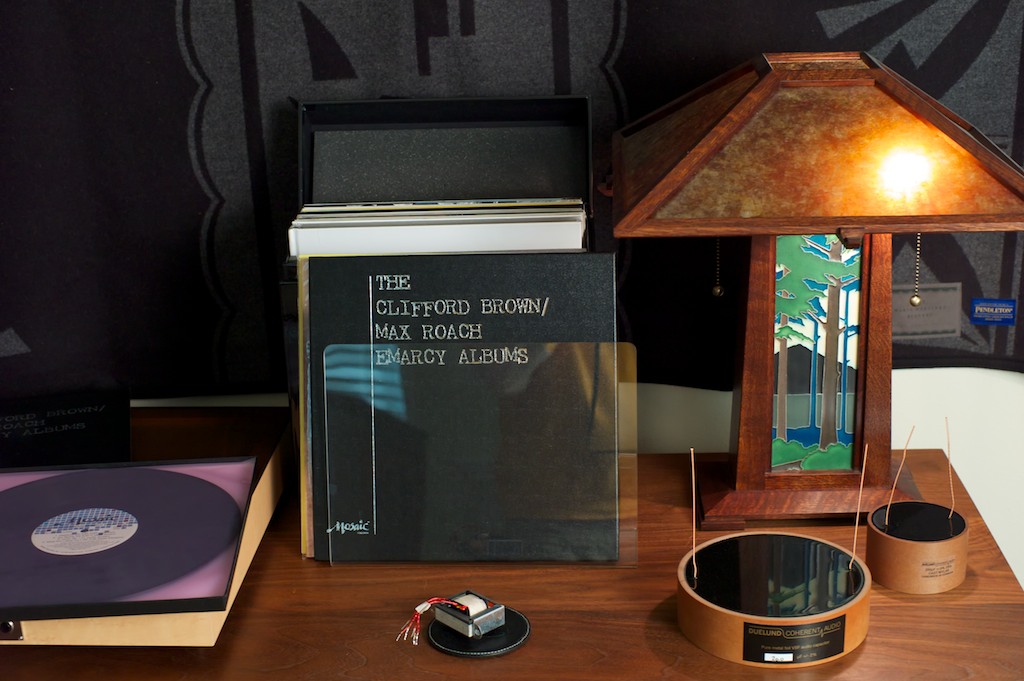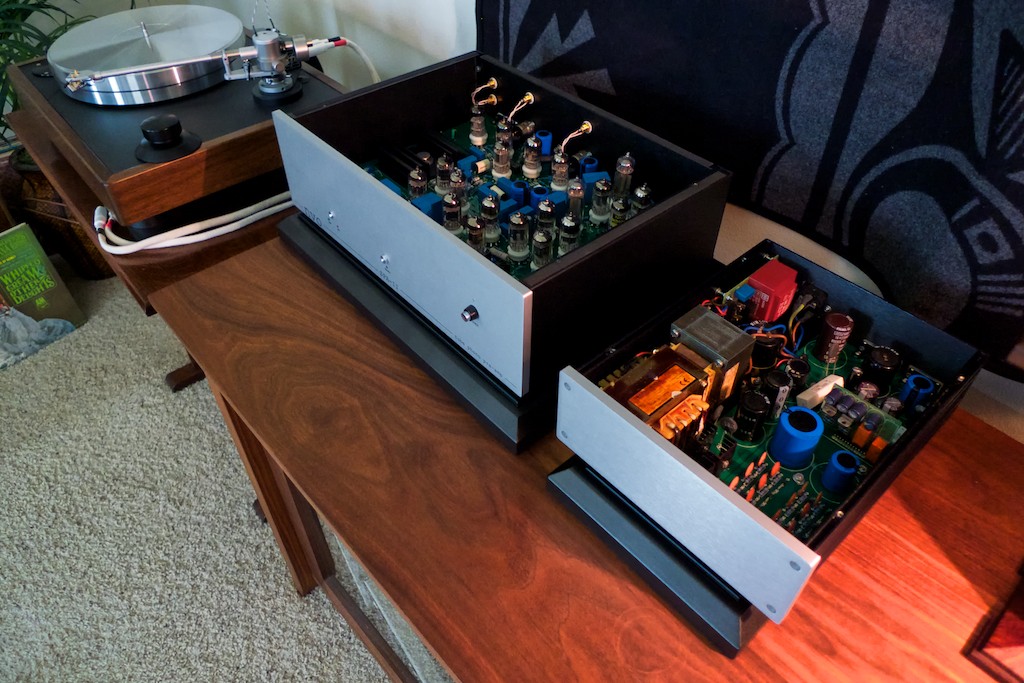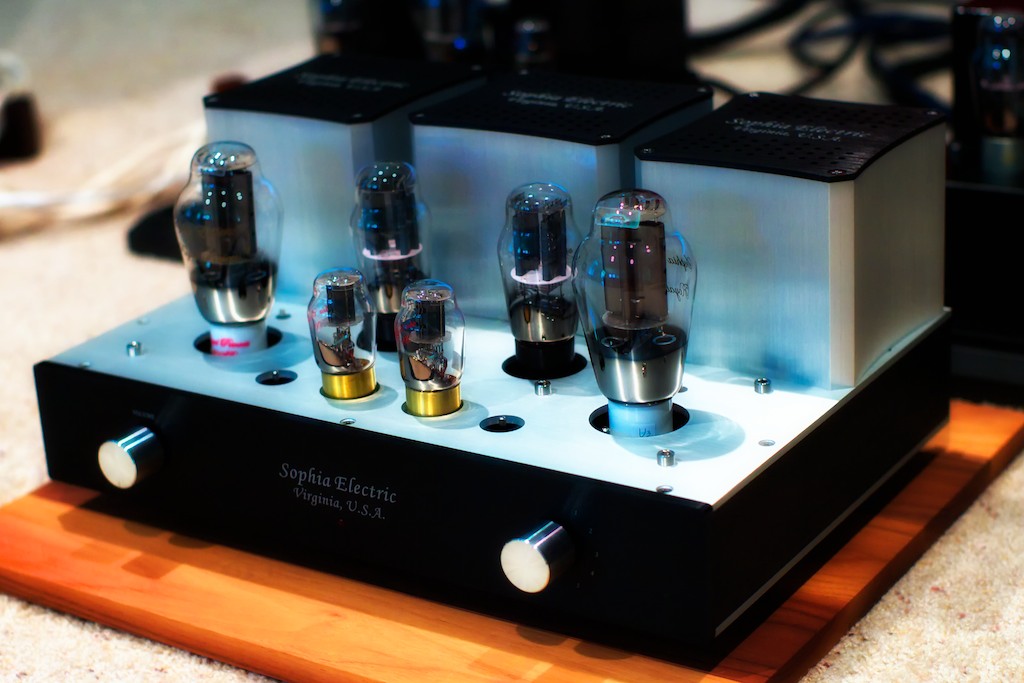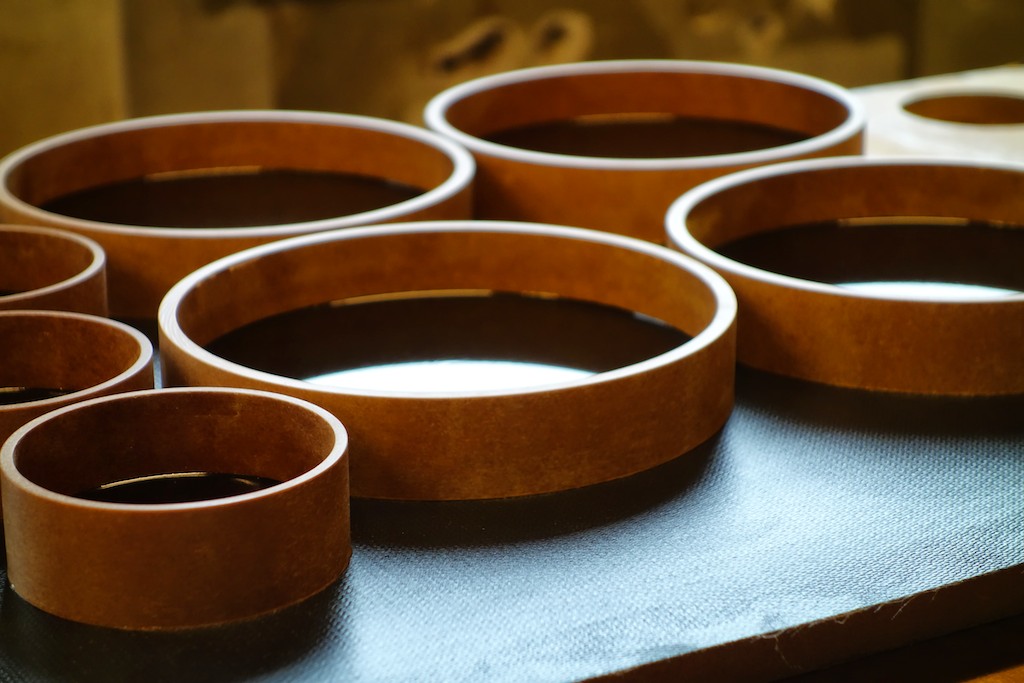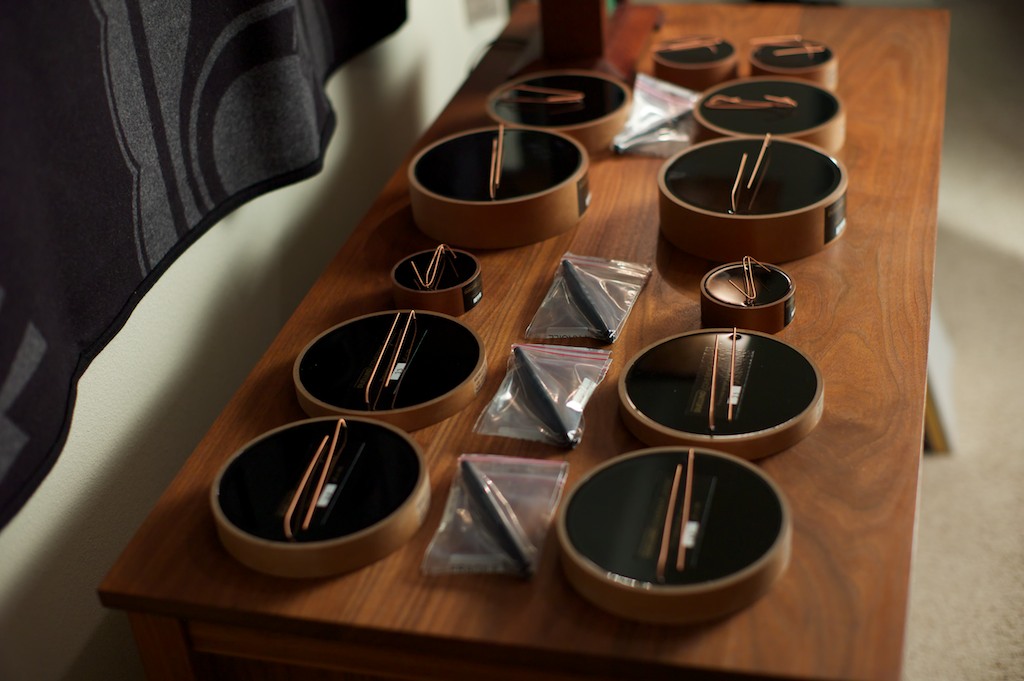I was chatting with Frederik Carøe in Denmark this morning by email while waking up with some nice hot coffee (medium roasted Kenya beans). I wanted to give Frederik an update on how things are going with the Duelund-WRSE Project, and ask Frederick for any suggestions he might have on improvements and such.
I thought you'd enjoy hearing about my preliminary listening impressions that I shared with Frederik, and in fact I'm giving you an expanded version with a little more detail.
I don't have stereo Duelund crossovers to report on yet, as I'm still putting the second pair of HF & LF crossovers together for the right channel Westminster Royal SE. (above) I'm almost done with the HF section, and I hope to finish everything up and connect it the speaker today so I can give it a listen before the sun comes down on the weekend.
While unorthodox & unplanned, it's actually been kind of interesting gathering preliminary listening impressions with the Duelund HF & LF crossovers hooked up only on the left channel, and with the stock Tannoy HF & LF crossovers on the right channel.
It occurred to me that was going to be the only way I could offer you real time comparative listening to the changes wrought by the Duelund HF & LF crossovers versus the stock Tannoy crossover, because once the stock Tannoy crossovers are disconnected and the stock wiring harness has been removed its not really possible to hook them back up to do listening comparisons without going through a major amount of hassle.
So this is it my friends for real-time comparisons of the Duelund HF & LF crossovers to the stock Tannoy HF & LF crossovers, and so after this it will be discussions about the full implementation of Duelund HF & LF crossovers for the Westminster Royal SEs. I spent almost the whole day Saturday listening in this Duelund left channel & stock Tannoy right channel mode so I could give you some insights on the differences between the two crossovers. It was a bit of a weird experience for my ears, almost like listening to two different loudspeakers as a stereo pair, and trying to report on the difference between the two. I don't recommend you try doing this listening approach yourself, you should just skip ahead to listen to the full Duelund'd WRSE when you do your own project, but I thought it would be interesting for you to hear my impressions in this mode before I move on.
I've been listening to some old favorite LPs, as well as some new ones that just arrived that I bought from Acoustic Sounds (The Clifford Brown / Max Roach Emarcy Albums box set, and a couple of Chet Baker albums).
My first impressions are this: Oh my God - what a difference! In the most general sense, all the things that I know and love about my Westminster Royal SEs are intact, but enhanced to a remarkable degree. With the Duelund components the inherent voicing of the WRSE is retained, which is what I was hoping for, but the performance level is rather dramatically increased.
For my listening impressions yesterday & today I ran the New Valve Order SPA-II phono equalizer directly into the Sophia Electric 91-03 300B integrated amplifier that I posted about earlier.
It's always a little bit exciting for me when I first fire up a system after having made some mods to electronics, not knowing for sure if there will be some unanticipated operational mishaps. When I first fired up the system to warm up, everything seemed to be ok, so I walked over to listen to the stock right channel WRSE, and then walked over to listen to the Duelund'd left channel WRSE. My heart sunk - I couldn't hear anything coming from the WRSE's Dual-Concentric driver in the left channel.
I figured there was a loose connection somewhere so I put on an album and figured I'd jiggle wires until I figured out where it was. To my surprise music came out of both channels of the WRSEs, the Duelund HF & LF crossover was just so much quieter than the stock Tannoy HF & LF crossovers that I thought it wasn't working, but it was - it was just very quiet with no music playing. I told Frederik about this result and he told me:
"I’m thrilled by your description. The silence is my main thing, as this really makes the music exist. Without silence there can be no detail. What you are hearing is the lack of resonance that was present in the old crossover, meaning that the speakers were never silent and never controlled."
All I can say is that I was floored by the difference between the two crossovers, the Duelund HF & LF crossovers were so quiet. The low noise level that results from the resonance control of the CAST process and the choice of materials that Frederik uses in creating his components works amazingly well, that's for sure.
On the Duelund XO'd WRSE side of the room there was a massive increase in sense of recorded space and room ambience, which I suspect was contributed to greatly by the Duelund LF crossover. There was also a dramatic increase in transparency. The soundstage really opened up with something like double the depth, more height, and a very distinct layering of images back into the recesses of the soundstage. The images were solid and naturally presented, with a sense of ambience and space around them. The stock Tannoy crossover sounded two-dimensional and opaque in comparison to the Duelund.
It was a bit weird hearing this major positive transformation of the sound & musicality from the Duelund HF & LF crossovers on the left side of the room, while the right side of the room sounded ... well not so good in comparison. I wouldn't characterize the stock WRSEs as a bad sounding speaker, far from it! It's an amazingly musical instrument of a loudspeaker! However, with the Duelund crossovers in place the Westminster Royal SE goes to a totally new level. I've got to get the right side up and running with Duelund!
As I said, the Duelund side is very quiet from a background noise standpoint. Particularly on good recordings, until an instrument comes in you almost think its not working, and then magically the instrument fills the room with music. The presentation of the music is also so much more natural and relaxed sounding with the Duelund crossovers, and it feels more like music if that makes sense. The stock Tannoy crossovers are harsh & edgy sounding in comparison, although I would never have characterized them that way had I not heard the Duelund crossovers, which sound so utterly natural and musical.
What the Duelund HF & LF crossovers do for the sonics and musicality of the Westminster Royal SEs reminds me a lot of what the superb ASR Emitter II Exclusive Version Blue amplifier does for them, it brings out the best in the West's. There's an exception in the comparison though, because with the Duelund crossovers in place there is a whole level of information that comes through the West's in terms of shades of tonal colors, musically natural timbral detail, emotive qualities, and important & relevant sonic & musical information that I'll tell you about in more detail at a later time. It really is a big deal.
With the Duelund crossovers there is less sense of strain on dynamic peaks, and the dynamic contrasts across the dynamic range from softest to loudest are more discernable. Dynamic transitions to crescendos, decrescendos or diminuendos become revelatory with the Duelund crossovers.
The Duelund crossover also plays much louder without any harshness. It was a bit weird feeling my right ear shut down on the stock Tannoy crossovers as loudness increased, while the left ear was unfazed and relaxed on the Duelund side.
Ok, those are some first impressions for you, and I'll have a lot more to say about sonic & musical attributes of the Duelund crossovers, but now its time for me to get back to work on the right crossover so I can listen to the full set.
Frederik asked me what the path forward is now, so I'll share that with you too. As soon as I finish up the right channel Duelund HF & LF breadboard crossovers here's what I plan to do: Eventually the yellow wire nuts will all be replaced in the final design with WTB crimp connectors, which Mark Coles tells me sounds better than soldered connections. There will be a few soldered connections using WTB silver-lead solder where crimp connections are not practical.
The copper set screw lugs for the energy & roll-off adjustments will probably stay unless I can figure out a better way to do it. Suggestions are always welcome! 🙂
I will probably keep using binding posts in bypass mode for cable connections from the speaker and amp to the crossover, that way I can disconnect the crossover when I need to move the speakers around.
I'll install the full set of Panatela component internal wiring for the Westminster Royal SEs that Mark Coles is developing, which will make for a full set of Panatela from amps to drivers.
I'll rewire the crossovers with 20-gauge Neotech single crystal silver hookup wire on the HF crossovers, and 14-gauge Neotech single crystal copper hookup wire on the LF crossovers.
For the final chassis configuration I'm thinking of mounting all the components on top a walnut platform (mono amplifier style), perhaps with some vibration damping material under each of them, with the platform resting in a matching quartz isolation platform, sitting atop large brass footers.
I think walnut (to match the WRSEs) contrasted with all brass hardware will look nice with the coloring of the Duelund components. I think I will position the Duelund crossovers behind and between the WRSEs monoblock amp style, first because I think they look really nice, with the added benefit that I can give Frederik a little extra visibility for his Duelund CAST components in photographs during future reviews. I am thinking of making some sort of brass emblem that says "Duelund" that I can mount on the crossovers so it will be visible from the front when taking photographs, that way everyone will know what they are looking at and that it is something very special.
At some point I'll condition all the wire and components on the Audiodharma Cable Cooker to get the last measure of performance out of them.
I'll probably do some other fine artful touches to make everything look pretty and tasteful.
Ok, I've got to go do some more work, but there's much more to come - we're just getting started!
Thanks for stopping by!





